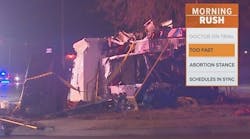We thank Contributing Editors William Goldfeder and Mark McLees for helping compile these reports. We again invite readers to share their experiences. You may send them to Chief Goldfeder at [email protected].
Experience Counts
We responded to a possible structure fire at a meat market at about 8 A.M. The chief arrived and had noticed nothing at the time; I was on the first-arriving engine. The chief positioned us in front of the building and gave the order to gain entry into the store because now there were wisps of smoke from the eaves. I forced entry and noticed upon opening the door the smoke was traveling outward. I then positioned myself behind the captain, who was behind the nozzleman (the second engine was just arriving) and we commenced to gain entry.
I am always aware of my surroundings, and this time it paid off, BIG TIME. As we were making entry I looked again at my surroundings. This time, the smoke had changed direction and the fire was taking its gulp of fresh air. I had time enough to say "Get the ..." and I was looking at a ball of flame like never before as well as at two firefighters in front of me. I jumped back, hose in hand and at the same time they did, and all on top of me. I fear if I had not noticed the change, we would have made our advance a few more feet and it could have been bad. We were lucky.
The aftermath: the side of our engine needed waxing, the hose cover was a little burned, the lights and reflectors melted a little, and the chief wished he'd parked us elsewhere.
A bad case of tunnel vision can get you hurt or your brothers hurt. I was able to pick up on the signs the fire gave us. Something to be said for experience.
Always Know Where You Are
Several years ago, on an extremely cold night, we were first-due at a carriage house fire. As manpower goes and the report of a working fire, even though I was first assistant chief, the initial engine was driven by yours truly.
After setup, and the second-due department arrived, several personnel entered the building through a second-floor window. Shortly afterward, it was reported a firefighter had fallen though a hole in the floor down into the fire floor. At this time, my location was near the first-floor entrance. I entered quickly and located the endangered firefighter - and discovered that he had actually fallen down a flight of stairs.
When injuries become just pride and not physical, humor does play into it, especially when it is realized the firefighter was also a training instructor. He should have known better than to place himself in the position that caused this "near miss." This certainly could have been worse because one fire victim was transported for scorched hair and facial burns.
Control & Accountability
The day after Thanksgiving, we received a 911 call at 4:30 P.M. for smoke showing at an inactive restaurant/bar approximately three miles from the station. I was on the scene quickly and requested multiple units before arrival. I confirmed heavy fire in the roof areas. Command was established, tankers were called and LDH (large-diameter hose) was laid to a nearby creek. I also special called two ladders.
As I think about this incident today, there were two distinct things that occurred:
- The initial attack was potentially disastrous because the firefighters did not observe the conditions - a haze in the first-floor areas. They did not check the second floor with a handline in tow. The fire broke through the back roof over the kitchen and almost cut off the second-floor crew.
- Two ladders were in position with the front one operating over the main section. Handlines were in operation when I made the call to "clear the building."
The two ladders went into "surround and drown" mode. The next thing I heard was "firefighters down" in the building. My heart went to my throat. WHY did this happen? They were found a little weary and soaked, not seriously injured, transported and released.
Several critiques were held, and with video available, it helped to show the lack of control and accountability with individual mutual aid agencies at this scene. Personally, it was one of the most stressful incidents I ever commanded. I recognized it early, and requested other chiefs to assist at the command post. Some people criticized the time that was spent in overhaul, but in retrospect, we did not have to go back for a rekindle.





